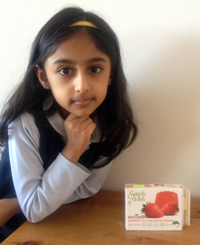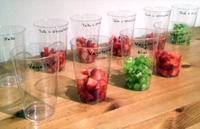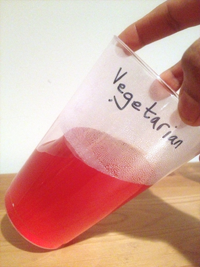First Grader Puts the Science of Fruits and Gelatin to the Test
You like your gelatin desserts solid and jiggly but not runny, right? A kitchen chemistry experiment reveals why certain gelatin and fruit combinations might appear at a potluck or picnic and not others. For this student and her family, the desire to turn her first grade class science experiment into a vegetarian-friendly one led to an interesting and enlightening twist on the science experiment.

Above: First grade student, Riya, with a box of vegetarian gelatin she and her mother used to create a new science project that extended the experiment Riya's class was doing. Below: Riya's variation on the Science Buddies Which Fruits Can Ruin Your Gelatin Dessert? project gave her a whole new set of combinations to try! She and her mother were very organized and systematic in preparing their testing cups and carrying out their hands-on experiment at home.


When it comes to exploring chemistry with students, kitchen science often provides a fun and accessible conduit for hands-on learning. Mixing up two different batches of a favorite recipe and changing the amount of a single ingredient may yield dramatic differences in the resulting cookies, muffins, or baked goods. Kids and adults can compare, observe, and talk about the science involved while munching on the snack and performing their own taste tests. Or, for non-edible kitchen fun, classes and families can turn milk into plastic, mix up putty, or even make dough that can be used in an electronics experiment.
For Riya, a first grade student at a New York City public school, a recent classroom science project set the stage for learning about the relationship between proteases and proteins. But when Riya's family gave the project a vegetarian twist, she learned that there are always new science questions to ask and unexpected discoveries to make!
Riya's teacher was using the Which Fruits Can Ruin Your Gelatin Dessert? project with her class. At school, the students talked about the experiment, about gelatin, and about the fact that some fruits can be combined successfully in a gelatin dessert and some cannot because of way the proteases in fruits interact with the protein in gelatin. With plans to test gelatin alone, gelatin and kiwi, and gelatin and strawberries, the students formed their hypotheses about what would happen.
Given that gelatin has to be cooked, and because they needed many samples for a classroom demonstration, Riya's teacher called upon the assistance of a few class families to prepare the gelatin samples at home to bring into school. Riya's family volunteered to make batches of gelatin with two different fruits.
In theory, the take-home kitchen chemistry task was simple enough. But Riya, a vegetarian, didn't want to eat gelatin (which is made from and contains proteins from bones). (Eating the gelatin was not required as part of the experiment, but the teacher had told the students they could taste the gelatin samples at the end of the experiment, an idea that "grossed out" Riya, says her mother, a neuroscientist at Hunter College.
Riya's mother, also vegetarian, says she had never prepared Jell-O® before, but she has worked with it in her own science experiments. "I knew Jell-O came from gelatin, denatured collagen. I have used gelatin for my research. It makes a good substrate for growing cells and attaching brain and other tissues sections for staining because it is protein."
Faced with her daughter's resistance to the gelatin project, however, Riya's mother got curious. Surely vegetarian alternatives are available? "I went into an organic store looking for a vegetarian version, and I got lucky and found one. As expected, the vegan gelatin was made from seaweed and did not have any protein."
With a vegetarian gelatin alternative on hand, Riya's family decided to conduct an alternate test—one that raised new questions for Riya and her family. Vegetarian gelatin doesn't contain the proteins that are found in regular gelatin, the proteins that react with proteases to make some gelatin-fruit combinations work and turn others into a soupy mess. Would vegetarian gelatin behave differently with fruits?
A new hypothesis was in order—and a new experiment.
Riya and her mother conducted their own gelatin and fruit test at home, a parallel experiment to the one the class was doing. For Riya, the project was a wonderful learning experience and a reminder that a simple question can be approached in a variety of ways. Riya and her family enjoyed conducting this kitchen chemistry experiment in conjunction with the first grade class's science lesson and were excited to put their science question to the test and observe the results.
Riya's experiment with vegetarian gelatin in the Which Fruits Can Ruin Your Gelatin Dessert? project has also been added to the "Make It Your Own" tab as a variation on the project that students can investigate.
If you really want to mix certain fruits for gelatin desserts, should you start with a vegetarian gelatin? Put it to your own scientific test!
Categories:
You Might Also Enjoy These Related Posts:
- Making Recycling Sorting Machines—STEM Success
- Mini Trebuchets and a NM MESA Challenge
- Helping Students Build Coding Skills with Drones and Self-Driving Cars
- Middle School Student Codes to Improve Life with Visual Impairment
- Student Science Project - Designing and Coding a Video Game to Help People with Alzheimer's
- Teacher Combines Computer Science and Engineering Design for Middle School Students - STEM Success Story
- A Mirror Maze Success Story
- Paper Roller Coasters and Energy Transformation: STEM Teacher Success Story









